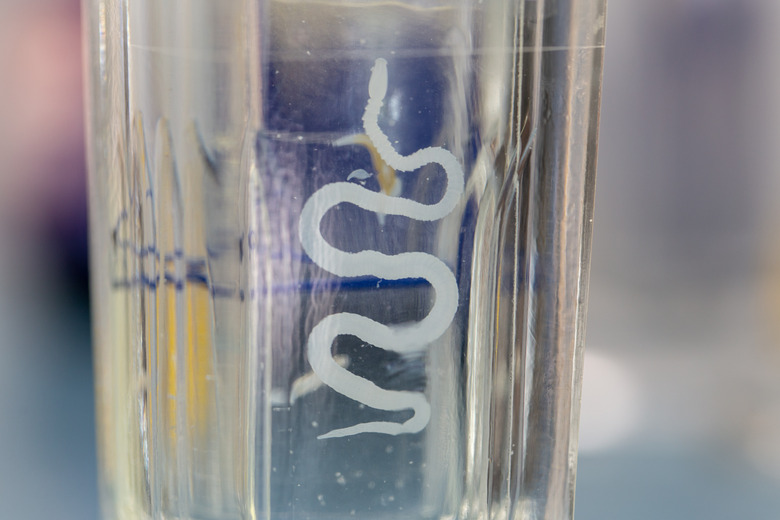Labeled Parts Of A Tapeworm
Drawing a diagram an be a helpful method for learning the parts of a tapeworm A diagram of a tapeworm should include labeled parts that show how it attaches to its host and how it reproduces. A cross sectional diagram can show the tissue layers that make up the body of the tapeworm.
Tapeworm Classification
Tapeworm Classification
Tapeworms belong to the phylum Platyhelminthes, which are flatworms. Some flatworms are predators but others, such as tapeworms, are parasitic. Tapeworms infect humans and many other types of vertebrates.
Platyhelminthes such as tapeworms have three layers of body tissues: endoderm, mesoderm and ectoderm. The mesoderm is the middle layer consists of muscles that allow flatworms to move on their own. The outer layer of ectoderm makes up the worm's outer body covering. Rudimentary organs lay in the innermost layer: the endoderm.
Tapeworms belong to the class Cestoda. All the Cestodes are parasitic and have a similar body plan, consisting of a head, neck and a long, ribbon-shaped body that is made up of a series of segments.
Tapeworm Life Cycle
Tapeworm Life Cycle
Humans can be infected with tapeworms by inadvertently ingesting eggs from water that has been contaminated by animal feces or by consuming larvae in undercooked meat. An adult tapeworm can only grow in a human if larvae have been ingested by eating undercooked meat from an infected animal, such as pigs, cattle or fish.
Larvae called cysticerci make their way through the digestive tract and attach to the wall of the small intestine. An attached larva matures into an adult tapeworm and begins reproducing. Eggs move through the host's digestive tract and exit the body in feces. The adult tapeworm can grow to a length of several meters as its body snakes its way through the intestines.
Making a Diagram of a Tapeworm
Making a Diagram of a Tapeworm
A diagram of a tapeworm should include labeled parts that provide an overview of its anatomy. The head is composed of parts for attaching to the intestinal wall of the host. The rest of the body consists of a series of segments. As the adult ages, it adds more segments to its body.
Flatworms in general do not have a circulatory system and tapeworms specifically do not have a digestive system. They do have a simplified nervous system, as well as reproductive organs that can be labeled. A cross sectional diagram can show the three layers of tissue that surround the central body cavity, including pores that allow materials to pass in and out of the tapeworm's body.
Parts for Attachment
Parts for Attachment
The head of the tapeworm is called the scolex. The rostellum is the area at the tip of the scolex that attaches to the intestine. The rostellum is surrounded by a ring of small, sharp hooks that imbed in the intestinal lining and anchor the tapeworm to the host.
Below the rostellum, four circular suckers surround the base of the scolex. The suckers also aid in anchoring the tapeworm to the host. Some species of tapeworms lack hooks and are held in place solely by its suckers. The neck extends away from the scolex and connects with the first body segment.
Parts for Reproducing
Parts for Reproducing
The rest of the tapeworm's body consists of a series of body segments called proglottids. Proglottids closest to the scolex are the youngest and those farthest away are the oldest. Mature proglottids contain both male and female sex organs. Male reproductive parts include testes where sperm is produced and the vas deferens, where sperm travel to fertilize the eggs.
The female reproductive parts include:
- Ovaries, where eggs are produced
- Oviducts, where eggs travel for fertilization
- Uterus, where eggs are stored
Cross Section of the Body
Cross Section of the Body
A cross section of a tapeworm reveals the ectoderm, mesoderm, endoderm and central body cavity that make up the tapeworm structure. Tapeworms absorb nutrients from their host and the nutrients pass through pores in the ectoderm. Ectoderm also contains genital pores for the release gravid, or fertilized, eggs that are ready to pass out of the host.
A cross section can also show the excretory canal that channels waste materials out of the tapeworms. Nerves and nerve bundles that serve as the tapeworm's simple nervous system can also be labeled in a cross section of the body segment.
References
- StatPearls: Tapeworm (Taenia Solium, Taenia Saginata, Diphyllobothrium, Cysticercosis, Neurocysticercosis)
- Florida State University Molecular Expressions: Tapeworm Scolex
- University of Hawai'i Manoa: Worms: Phyla Platyhelmintes, Nematoda and Annelida
- Fulton-Montgomery Community College: Flatworm Characteristics
Cite This Article
MLA
Mentzer, A.P.. "Labeled Parts Of A Tapeworm" sciencing.com, https://www.sciencing.com/labeled-parts-of-a-tapeworm-12266991/. 22 November 2019.
APA
Mentzer, A.P.. (2019, November 22). Labeled Parts Of A Tapeworm. sciencing.com. Retrieved from https://www.sciencing.com/labeled-parts-of-a-tapeworm-12266991/
Chicago
Mentzer, A.P.. Labeled Parts Of A Tapeworm last modified March 24, 2022. https://www.sciencing.com/labeled-parts-of-a-tapeworm-12266991/
